
Rediscovering Japan

Rediscovering Japan
Travel (Chino/Fujimi/Haramura)

by tomizuta
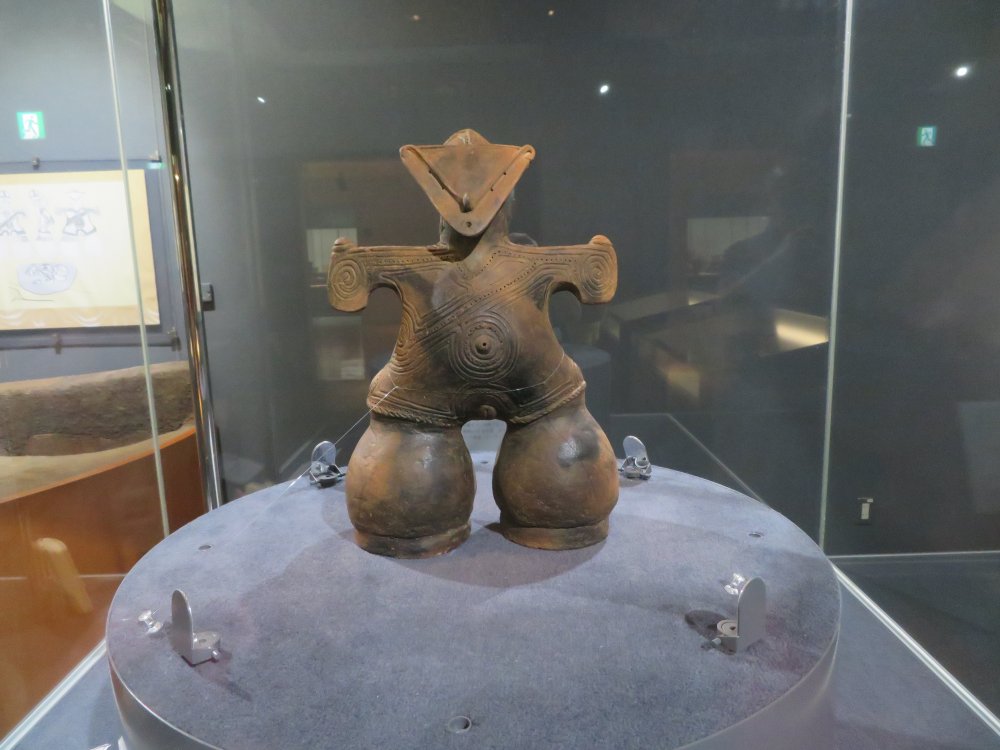
Of particular interest to me were the two doguus (clay figurines) excavated from Jomon sites in Chino City and designated as national treasures. Shown above is the Masked Goddess from around 2000 B.C. on display at the Togariishi Museum of Jomon Archaeology in Chino City.
In September 2020, we stayed over a week at our mountain house in Chino City, Nagano Prefecture. In an effort to stimulate the depressed economy due to the novel coronavirus, the government had launched the “Go to Travel” campaign under which the government would subsidize roughly one third of the travel costs. I pondered if I should take advantage of the campaign and visit Shirakawa-go in Gifu Prefecture, a World Heritage site, but decided to dismiss the idea as I didn’t feel comfortable enough to visit a popular tourist site when the coronavirus infection rate still remained at a high level. Nagano has a heritage of Jomon archaeology especially in the Yatsugatake Mountain Range area including Chino. Indeed, Chino City’s symbol is the Venus of Jomon, an earth baked doll from the Jomon period designated as a national treasure. I first set out to revisit the Togariishi Museum of Jomon Archaeology in Chino City, located on a mountain slope about ten kilometers west of the city center.
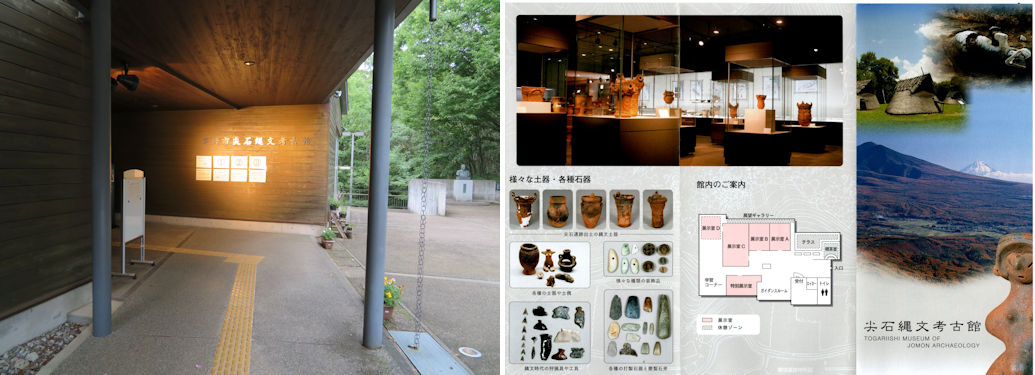
The entrance to the museum (left) and the museum pamphlet (right).
The museum has been built on the grounds of the Togariishi and the adjacent Yosukeone Jomon sites both designated special historic sites. It displays about 2,000 objects excavated from Jomon sites in Chino City. Of particular interest to me were the two national treasures, Venus of Jomon dated around 3000 B.C. and the Masked Goddess around 2000 B.C. On my previous visit, the Masked Goddess was on loan to another museum. This time luckily for me the Masked Goddess was on display, while the Venus of Jomon was on loan. Both clay figurines are quite large weighing over two kilos. I understand they are testimony to the high level of skills of the Jomon people. The displays of the stone tools and pottery excavated from the Jomon sites in Chino was also quite intriguing. The museum has a very good English guidebook which you can access by clicking here.
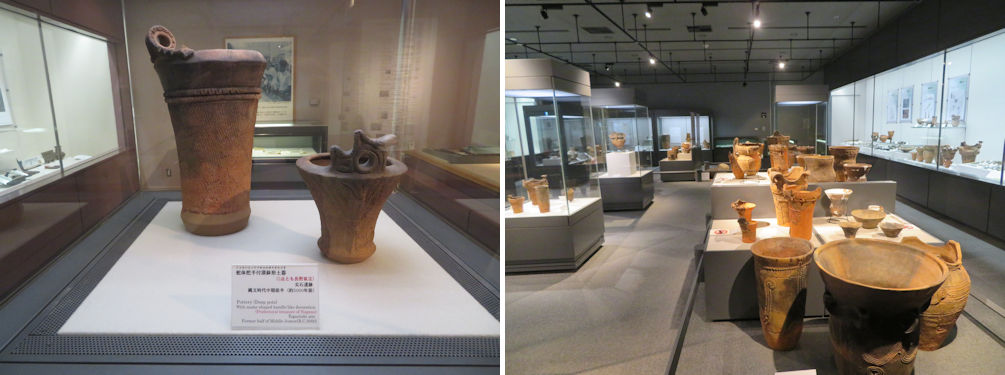
Two deep pots excavated at the Togariishi site (left). Full English description is provided which says "Pottery (deep pots) with snake-shaped handle-like decoration. Former Half of Middle Jomon (3000 B.C.)". An exhibition room (right).
I left the museum and followed the signs to the Yosukeone site where they have rebuilt six of the 28 excavated Jomon dwellings on their original sites. There is a spring on the south and the area is surrounded by forests, which I imagine was what attracted the Jomon people to this site.
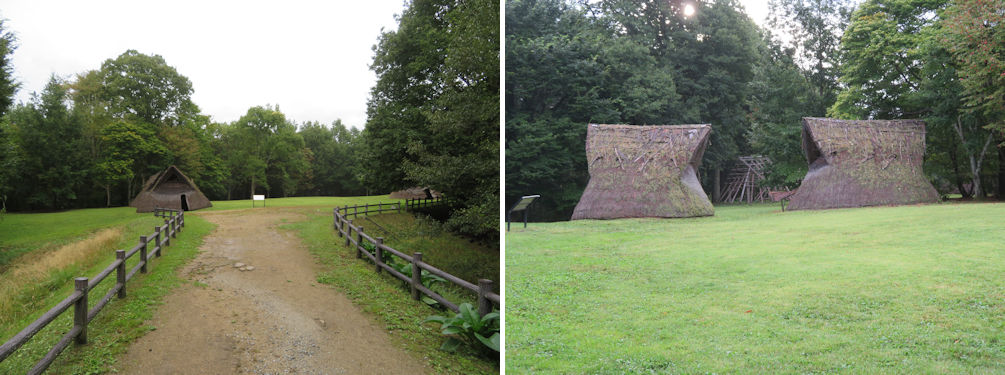
The path from the museum leading to the reconstructed Jomon settlement (left). Two reconstructed Jomon dwellings (right).
The neighboring towns of Haramura and Fujimi also have many Jomon sites. I found that Haramura Village has a municipal art museum that also displays Jomon objects excavated in the area, which I visited the following morning. The Yatsugatake Museum of Art is located on the western side of the Yatsugatake Mountain Range at an altitude of 1,350 meters above sea level. We parked in the museum car park which is a couple of hundred meters away from the museum. The site is surrounded by dense forestry. Along the path to the museum are some open-air sculpture by Takashi Shimizu from Haramura Village whose work is the main display of the museum as well as sculpture work of local junior high school students.
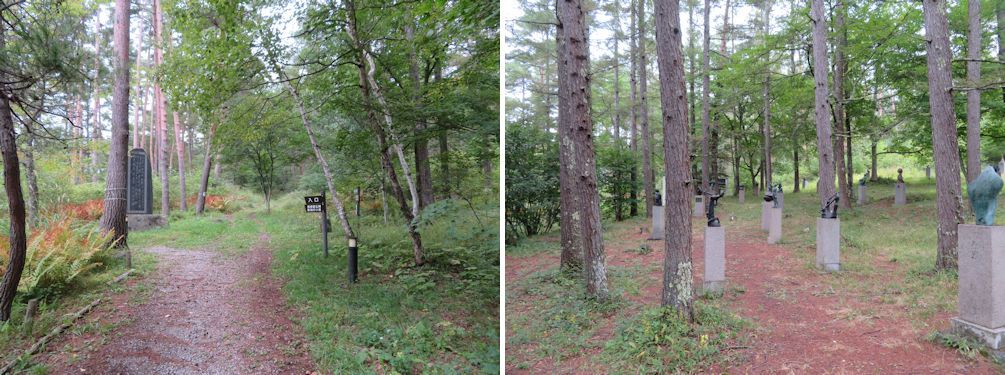
The path through the forest to the museum (left). The sculpture work of local junior high school students along the path (right).
I was also interested to learn that a historical military road from Japan’s civil war period in the 16th century ran through the forest. This is a virtually straight road called Bomichi (meaning straight road) through the mountains from the south of the mountain range to the north of Chino, purported to have been created and used by the powerful feudal lord Shingen Takeda in his battle with the rivaling feudal lord Kenshin Uesugi.
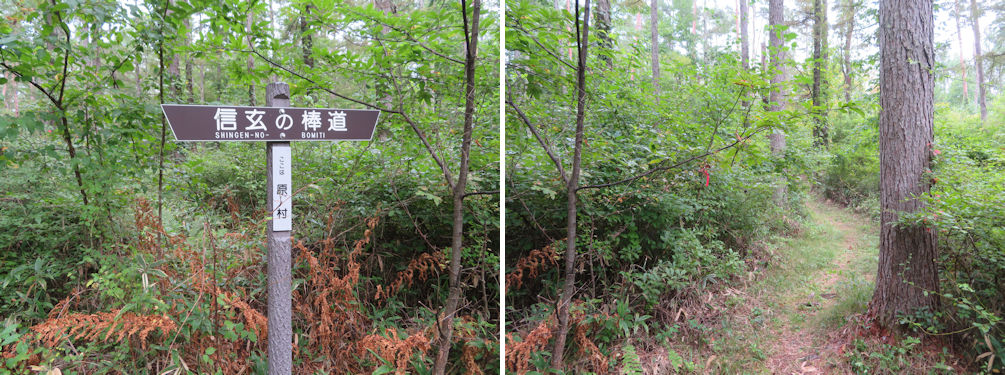
The sign post of the Bomichi (left) and what remains of the road through the forest (right)
The museum designed by the architect Togo Murano has a unique dome-shaped
structure reminiscent of the mountain range. The main rooms inside display
mainly sculptures and other artwork of Takashi Shimizu. The section at
the very end is dedicated to the Jomon objects excavated from sites in
the village. There is a diverse collection of pottery, tools and ornaments,
but what interested me most was the description of the archaeological sites
which was most informative. Photographs may be taken with permission but
reproduction unallowed. The most popular display is a vessel with a face-shaped
handle thought to be used as a lantern for rituals excavated in 1977 from
the Maeone Jomon site. With the increased interest in Jomon history, the
vessel was named “Fire Goddess Fuu” and has become a mascot character of
the village. Here is a link to the vessel on the museum homepage.
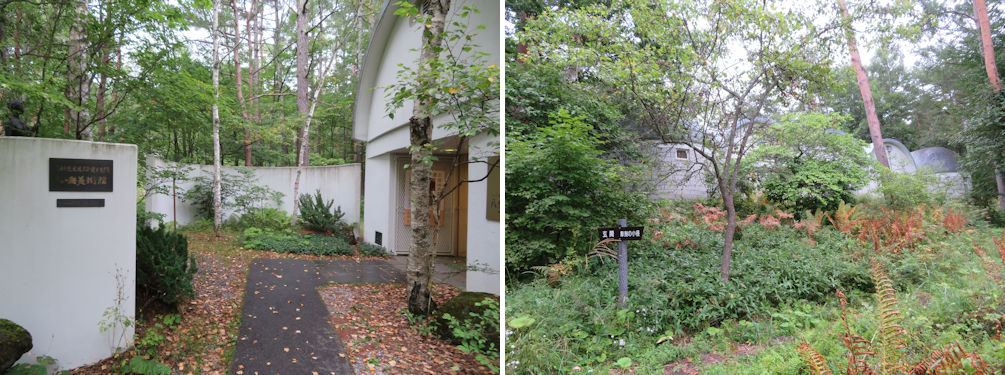
The museum entrance (left) and its unique dome-shaped structure (right).
I next went to visit two Jomon sites in the village, the Maeone site mentioned above and the Akyuu site. I struggled to find the Maeone site. I finally located the site area with the help of a map I found in a 1998 excavation report of the site. According to the description in the museum, it was the site of a relatively large Jomon settlement towards the end of the middle of the Jomon era (i.e. 3000 B.C. to 2500 B.C., with dwellings surrounding a plaza and burial area in the center. Objects from later periods become simpler and fewer, suggesting that living conditions in the area had deteriorated. There are no signs whatever of the site, and the area has been restored to its original state of fields and bushes. Clearly it was more important in the past for this village to increase farming areas than preserving archaeological sites, but perhaps this may change given the recent increased interest in Jomon.
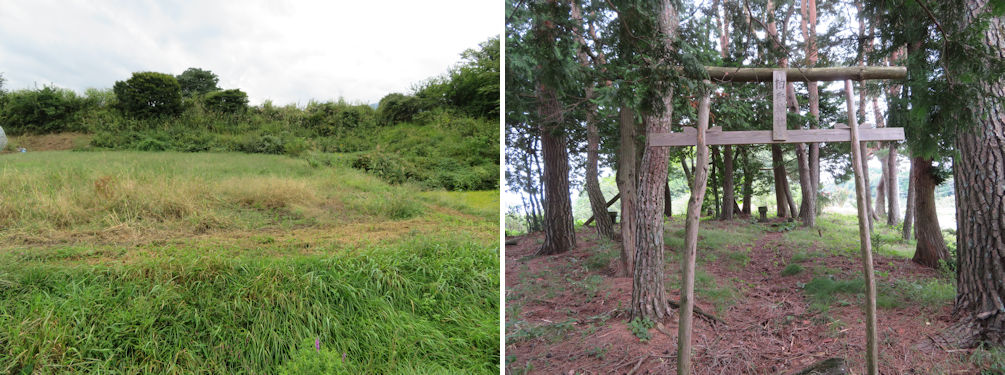
I finally located the site area with the help of a map I found in a 1998 excavation report of the site. There are no signs whatever of the site, and the area has been restored to its original state of fields and bushes (left). There was a Shinto shrine named Kasiwade Jinja in a small forest on the north side of the site. Perhaps this area was surrounded by forestry in the Jomon days (right).
From there I drove to the Akyuu site not that far from the Maeone site. This is a much older site dating back to 4500 B.C. not much later from when the Jomon people first settled in this area, continuing to the Heian period (8th to 12th century A.D.). The site was excavated in the late 1970s upon the construction of the Chuo Expressway and then buried and preserved in its original state. The Chuo Expressway passes through the center of the site. Rock pillars and large stones were installed in the center area which is believed to have been a special ritual and burial site. I had learned beforehand that the site had been buried and there would not be much to see, but thought it worthwhile to at least take a look. The site was easier to find as it appeared on maps and there were signs leading to the place. The area is in a forest and there was a sign at the edge of the forest with explanation of the site.
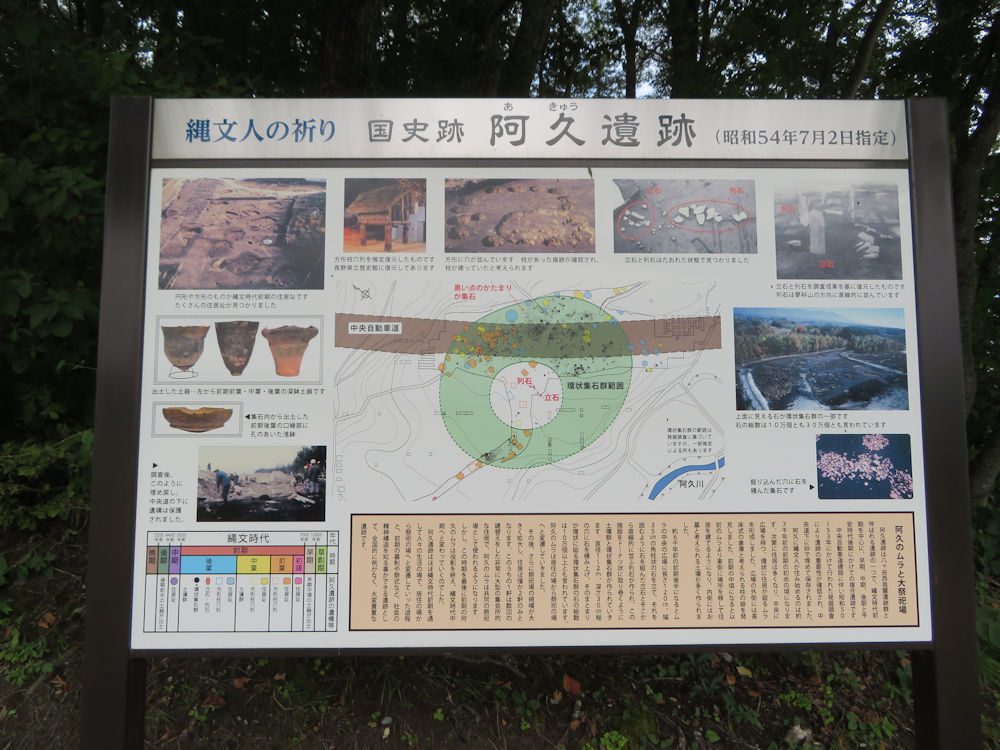
The area is in a forest and there was a sign at the edge of the forest with explanation of the site.
From there we followed a path leading toward the expressway. On the way there were some carved animals carved on felled tree barks, which I do not know by whom. There was a relatively clear area in the middle of the woods which I believe must have been the center area. I couldn’t find any signs of the site as I knew, but imagined that this was the type of forest where the Jomon people could hunt and collect their food.
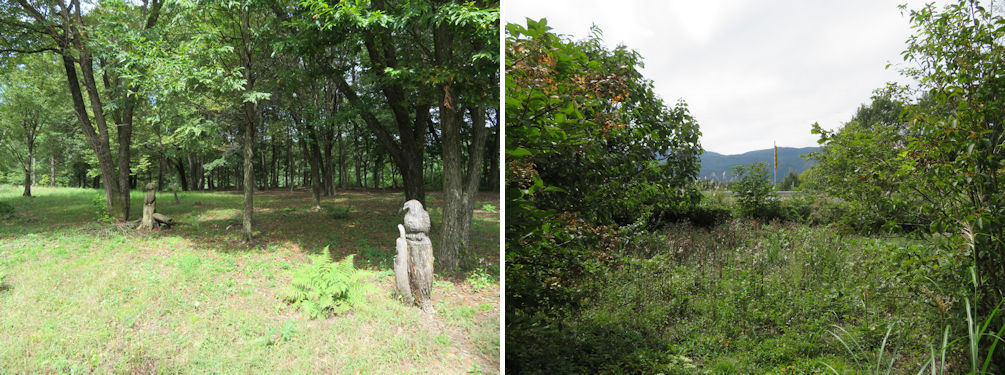
There were some carved animals carved on felled tree barks. I guess this is in part of the center of the site (left). Looking north to the Chuo Expressway a sone throw away (right). Most of the dwellings were on the other side of the expressway.
I visited the Yatsugatake General Museum not far from the city center of Chino. This is a museum that broadly introduces the nature, history, industry and lifestyle of the Yatsugatake area. They regularly host special displays. The last time I visited, there was an exhibition relating to the iron ore mine, one of the largest in pre-WWII in Japan, that existed in this area. I had revisited hoping to see some displays related to the Jomon period on this occasion, of which there were a few in the history section. I did learn for the first time that the people in this area lived in modest dwellings not that different from the Jomon days and that they worked for farms owned by the rich in Kyoto.
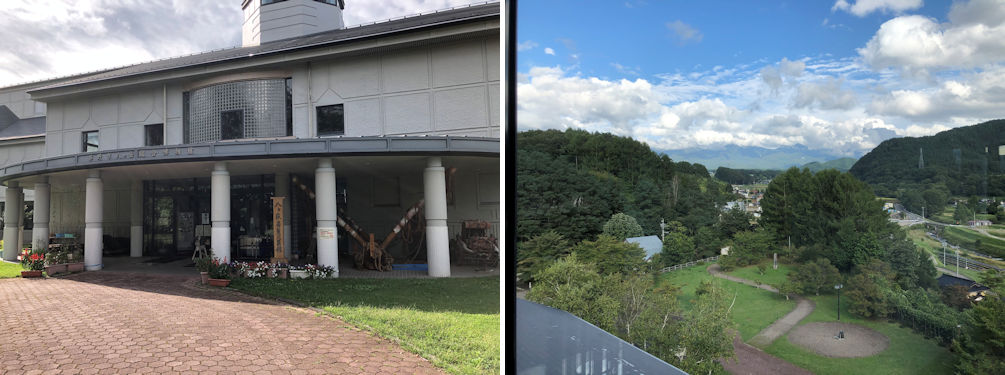
The Yatsugatake General Museum not far from the city center of Chino (left). You can go up the stairs to reach the rooftop from where you can command a spectacular view of Chino and the surrounding mountains (right).
I previously explained that there are Jomon sites in Fujimi Town neighboring Chino and Haramura. The next day I went to their Idojiri Archaeological Museum located on the Idojiri Jomon site, one of the many sites composing the Idojiri group of Jomon sites. This turned out to be a very interesting and rewarding visit. The Archaeological Museum is situated on a corner of Idojiri Historic Site Park (Idojiri Shiseki Kouen).
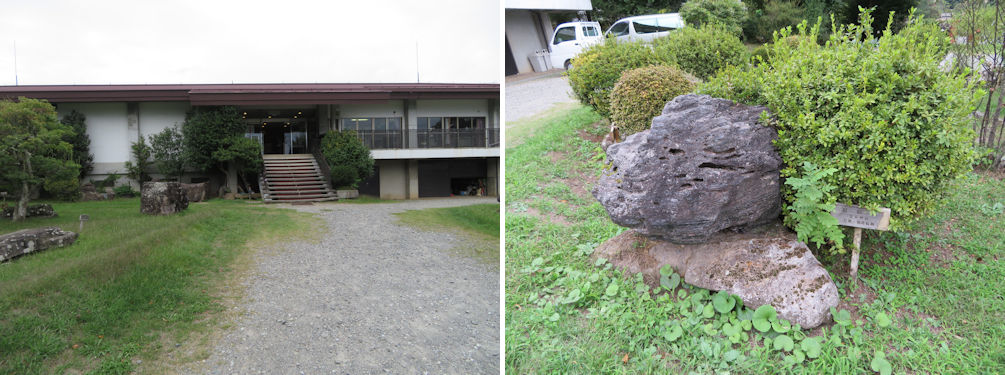
The Idojiri Archaeological Museum didn't look like a typical museum (left). There are outdoor displays of the rocks the Jomon people used for their stone tools. In the picture is an obsidian rock. Obsidian mined in the area was widely used in Central Japan to make stone knives and arrowheads (right).
The Idojiri Site group is composed of many sites in Fujimi Town from the earliest Sakadaira site (5000 B.C.) which may have co-existed with Akyuu site, to the latest Obana site (around 2000 B.C.). The peak of Idojiri was from 3000B.C., to 2500 B.C. when Idojiri Culture characterized by the mystic Idojiri pottery and its underlying spiritual belief and vast amount of farming tools. The museum’s collection of pottery, tools and ornaments was vast and very well arranged and explained (only in Japanese). On the various types of decoration (frogs, snakes, flame etc.) of the Idojiri pottery, some of the explanation provided stated that the decoration was related to the stories of the creation of Japan in the earliest chronicles Nihonshoki and Kojiki both written in the early 8th century. I have subsequently learned that the museum is advocating that the pot decorations are not just decorations but contain stories and beliefs as well as supporting the theory that farming had already started in the peak Jomon period, contrary to past understanding that farming started from rice growing from 500 to 400 B.C.
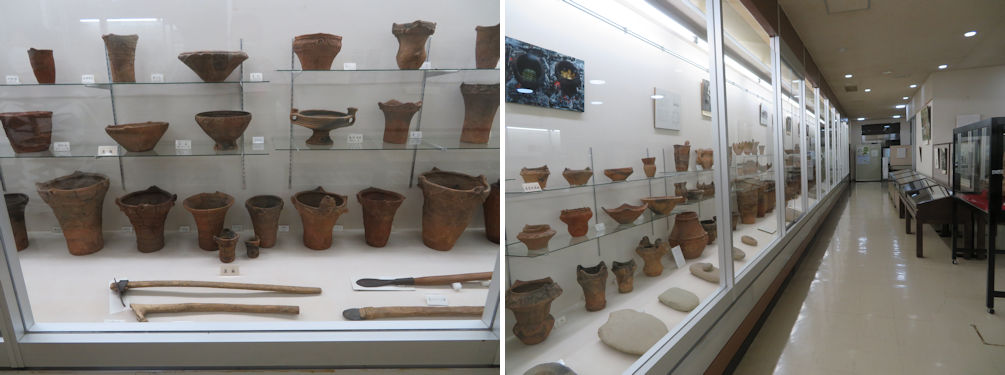
Display of various pottery from around 2500 to 2000 B.C. and farming tools (left) and a view of the inside of the museum (right).
I paid a brief visit to Fujimi Historical Folklore Museum next door. The admission fee was included in the 300 yen I paid at the Archaeological Museum. The displays were related to living in the area from the Middle Ages to modern times. There was nothing related to Jomon, so we quickly browsed the displays and left.
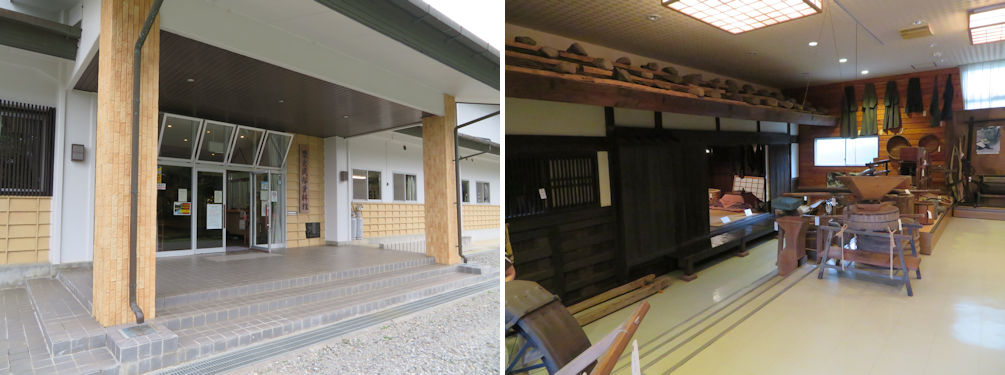
Fujimi Historical Folklore Museum entrance (left) and part of the display (right).
The two museums stand on a mount. We went the path downhill to an open area with a resurrected Jomon dwelling. The description by the dwelling told me that the Idojiri sites are located at the bottom of Mt. Amigasa, the southernmost mountain of the Yatsugatake Mountain Range, the Jomon people settled here from as early as 5000 B.C. and the peak of the settlement was from 3000B.C. to 2000 B.C. The dwelling has been resurrected in a style typical of the settlement in its heydays.
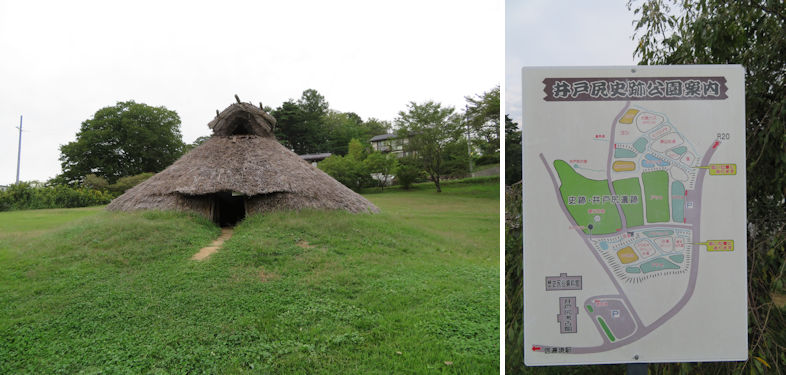
We went the path downhill to an open area with a resurrected Jomon dwelling(left). Map of Idojiri Historic Site Park (right). The two museums are on the bottom left and the Jomon dwelling is marked by a black dot.
Some former paddy fields in the park had been converted to lotus and iris fields. The ancient Oga Lotus germinated from more than 2000 years old seeds and later transplanted to all parts of Japan was here as well. Unfortunately, the flowering season was over and the leaves had started to wither. There were some beds for kakitsubata, a native nowadays rare Japanese iris, but again the flowering period was back in June/July time. It was an interesting tour of Jomon sites in the Chino/Fujimi/Haramura area.
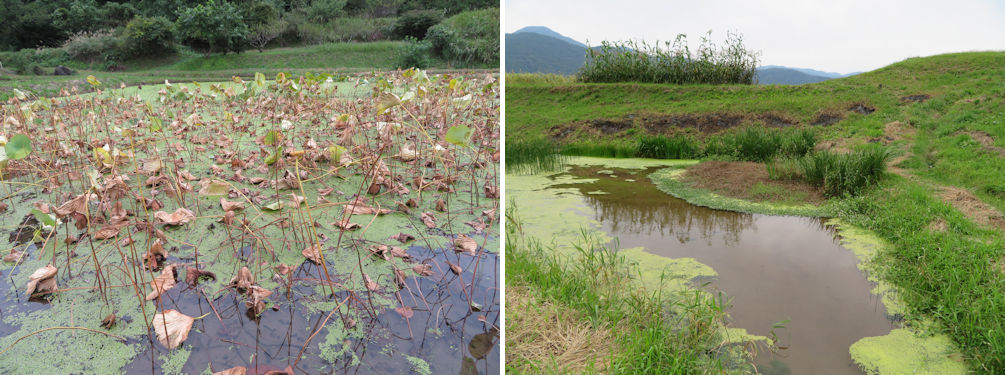
The flowering season was over and the Oga Lotus leaves had started to wither(left). There were some beds for kakitsubata, a nowadays rare native Japanese iris, but again the flowering period was back in June/July time.
We revisited the park in mid May 2021. To our delight we managed to find some kakitsubata flowers just starting to bloom. The kakitsubata were tucked away in the bushes by the wet flower bed.
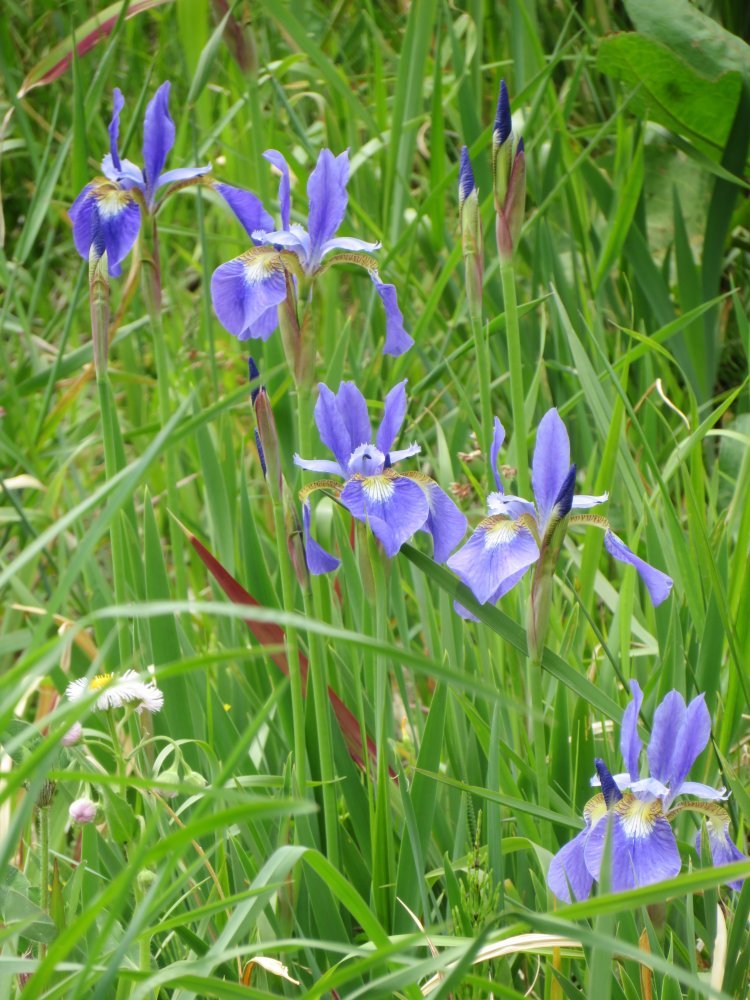
To our delight we managed to find some kakitsubata flowers just starting to bloom..
We paid another visit to the park in mid May 2022. I had done some homework on kakitsubata, ayame and hanashoubu, which all look very similar. I wanted to reassure myself that the flowers above were kakitsubata, To our dismay, the area where we had found the flowers had all been mowed. I had guessed they were kakitsubata, as they were growing on the side of a bank of a shallow pond shown on the park map as a kakitsubata area. But now looking at the picture it appears I was wrong and they were ayame flowers. All the areas were now dominated by large yellow shoubu (a type of hanashoubu). We were just about to leave when I found some purple flowers by a water lily pond. These were unmistakably kakitsubata, with their distinct white stripes inside the petals. I can only hope I will find them next year as I understand they are designated as an endangered species in many prefectures.
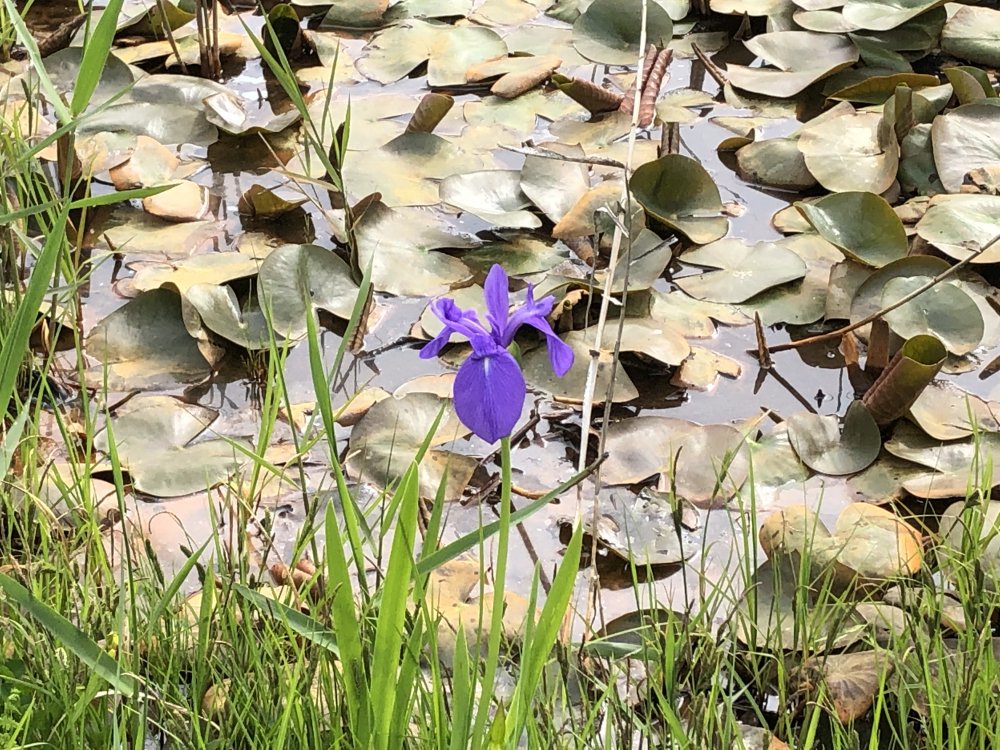
We were just about to leave when I found some purple flowers by a water lily pond. These were unmistakably kakitsubata, with their distinct white stripes inside the petals.
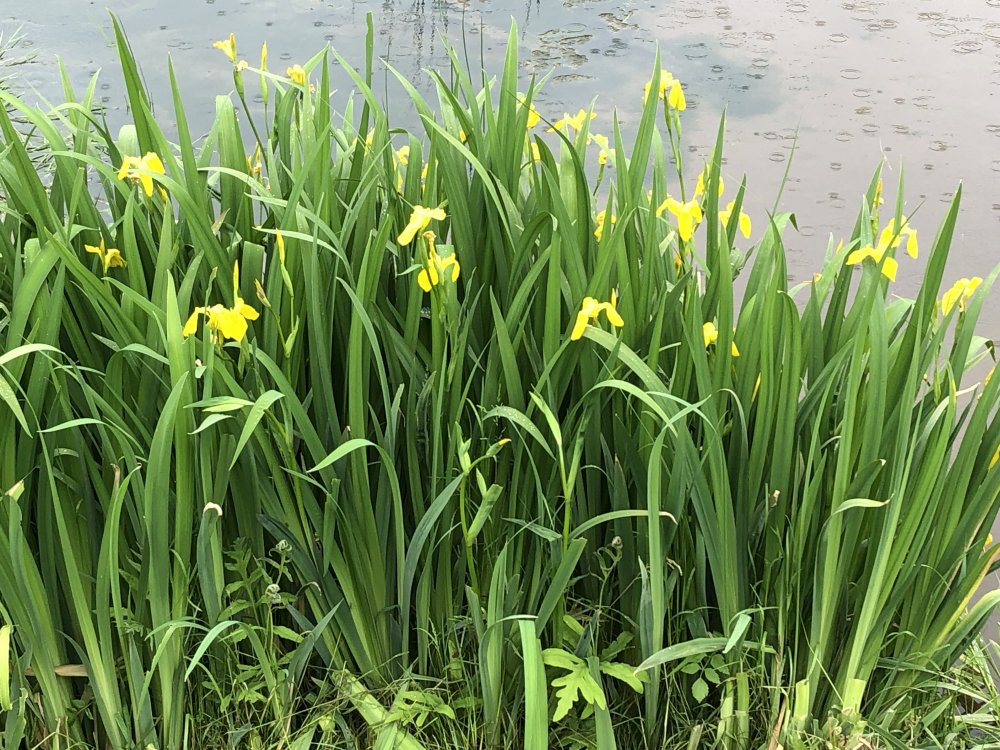
All the areas were now dominated by large yellow shoubu (a type of hanashoubu).